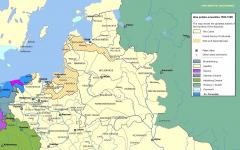The lesson schedule at a school, gymnasium or lyceum is drawn up taking into account the requirements of SanPiN 2.4.2.2821-10 “Sanitary and epidemiological requirements for the conditions for organizing training in general education organizations” (with amendments and additions): by the start time training sessions which should start no earlier than 8 a.m.; number of shifts; the size of the weekly educational load; distribution of the teaching load during the school week; the volume of the maximum permissible study load during the day; taking into account the daily and weekly mental performance of students and the scale of difficulty of academic subjects. Modern scientific research has established that the biorhythmological optimum of mental performance in children school age falls between 10 and 12 hours. At this time, the greatest efficiency of assimilation of material is noted at the lowest psychophysiological costs for the body. Consequently, in the lesson schedule for primary students general education basic subjects should be taught in lessons 2-3, and for students of basic general and secondary general education - in lessons 2, 3 and 4. Mental performance of students in different days The school week is not the same. Its level increases towards the middle of the week and remains low at the beginning (Monday) and at the end (Friday). In this regard, the distribution of the teaching load during the week is structured in such a way that its largest volume falls on Tuesday and (or) Wednesday. At the same time, the volume of the maximum permissible weekly classroom load during the day for students in grades 1 should not exceed four lessons, grades 2-4 - five lessons, grades 5-6 - six lessons, grades 7-11 - seven lessons. It is recommended to include physical education classes among the last lessons. After lessons physical culture do not conduct lessons with written assignments and test papers. Presentation of new material and tests should be carried out in 2-4 lessons in the middle of the school week. Subjects that require a lot of time for home preparation should not be grouped into one day.
Separate schedules are drawn up for compulsory and elective classes; it is recommended to take a break of at least 45 minutes between the start of elective classes and the last lesson. A set of exercises is carried out to prevent eye fatigue and physical exercise to prevent general fatigue, the use of tasks and activities of different nature in labor classes. What is important is the duration of the lesson (academic hour) of no more than 45 minutes, the organization of training in 1st grade (with a 5-day school week, in the first shift, with the organization of a dynamic pause of at least 40 minutes in the middle of the school day, training without scoring students’ knowledge and homework, organization of additional weekly holidays), the absence of double lessons in primary grades, the presence of a light school day on Thursday or Friday in the schedule, the duration of breaks between lessons is at least 10 minutes, big change-20-30 minutes; presence of a break between shifts and its duration of at least 30 minutes; prevention of fatigue, violations of posture and vision of students in lessons, alternation during the lesson different types educational activities. In institutions with in-depth study In individual subjects, lyceums and gymnasiums, training is carried out only in the first shift. In institutions operating in two shifts, training of 1st, 5th, final 9th and 11th grades and compensatory education classes should be organized in the first shift. Studying in three shifts in general education organizations is not allowed. The total volume of workload and the maximum volume of classroom workload for students should not exceed the requirements established by SanPiN 2.4.2.2821-10.
If the schedule in a general education organization is drawn up incorrectly, with violations of SanPiN 2.4.2.2821-10 “Sanitary and epidemiological requirements for the conditions for organizing training in general education organizations,” then for the identified violations legal entity, be it a school, educational center, gymnasium or lyceum, and officials impose administrative penalties.
According to SES magazine No. 7 2016.
Modern scientific research has established that the biorhythmological optimum of mental performance in school-age children falls within an interval of 10-12 hours. During these hours, the greatest efficiency of assimilation of material is observed at the lowest psychophysiological costs for the body. Therefore, in the lesson schedule for students of the 1st stage, the main subjects should be taught in 2-3 lessons, and for students of the 2nd and 3rd stages - in 2, 3, 4 lessons.
The mental performance of students is not the same on different days of the school week. Its level increases towards the middle of the week and remains low at the beginning (Monday) and at the end (Friday) of the week. Therefore, the distribution of the teaching load during the week is structured in such a way that its largest volume falls on Tuesday and (or) Wednesday. On these days, the lesson schedule includes either the most difficult subjects, or subjects of average and easy difficulty, but in greater quantities than on other days of the week. Presentation of new material and tests should be carried out in 2-4 lessons in the middle of the school week. Subjects that require a lot of time to prepare at home should not be grouped together on the same day.
Addition to the table I.G. Sivkov can use data from a survey of students in modern general education institutions, which include computer science, specialized disciplines, and subjects new to them among the most difficult subjects. These items should be scored at least 10 points. With a properly designed lesson schedule greatest number points for the day based on the sum of all items must fall on Tuesday and (or) Wednesday.
This distribution of the weekly teaching load should be strived for when drawing up a schedule for grades 9-11. For students in grades 5-11, the academic load in the weekly cycle should be distributed in such a way that its greatest intensity (based on the sum of points per day) falls on Tuesday and Thursday, while Wednesday would be a slightly lighter day. The schedule is incorrect when greatest number points per day falls on the extreme days of the week or when it is the same on all days of the week.
Document
Poor lesson schedule. School problems. Children's education. At the moment, a letter to the administration has been drawn up and signed by the majority of parents, links to the relevant requirements and recommendations of SanPinov have been given.
Discussion
Here we separated two Russians by physical education (
How they attacked;)))) Just like they were attacking the general peace! :)
Of course, go to the head teacher and ask to change the schedule. For those who don’t ask, nothing is changed. You're uncomfortable, say so. Perhaps the situation can be easily corrected.
And good luck!!!
On September 1, 2015, my daughter Sasha, like thousands of other children, went to first grade. Like many other mothers, I had to carefully prepare myself and prepare everyone in the household for the upcoming changes, some of which came as a real surprise to our family. First of all, our regime has changed radically. I get up earlier than everyone else, because I don’t want to get ready in the fuss, I prepare breakfast, then I wake up my husband and children.. We have breakfast, chat, discuss plans for the day, the children even have time...
March 21 (Saturday) 12.00–13.00 Ornithology lesson “Owls big and small.” Publishing house "Rare Bird" 4+ (Room 221) 12.00–14.00 Layout lesson. Studio "Letal Chagall" 3+ (Exhibition balcony 2nd floor) 12.00–14.00 Animation lesson. Center for Personal Development “Millennium” 8+ (Small Exhibition Hall) 12.00–13.00 Literature lesson. We read and discuss “Tales of the Tegumai Tribe” from the collection “Fairy Tales Word for Word” by Rudyard Kipling. Publishing house "Octopus" 8+ (Room 234) 13.00–14.30 St. Patrick's Day...
The child’s school field is simply no plus, the music school is covered, which we have been going to for a long time and successfully, since their group lesson schedule is based on 4 lessons for first-graders. What to do? At the parent meeting it was said that ICT is a requirement...
Discussion
There are SanPins, according to which in 1st grade the load should not exceed 21 lessons per week.
You can refer to it when picking up your child after the 4th lesson.
ICT in Federal State Educational Standards is integrated into school subjects. In theory, children should just work on poppies during lessons. At our school we also had an extracurricular activity with poppies, but it was not obligatory. I will not say anything about the fact that first-timers should still have a gentle regimen, at least in September.
Hello dear readers of the magazine. As you know, ramps for disabled people in our country are a problem: either they do not exist at all, or they are not installed according to the standard. The standard is that the slope of the ramp is no more than 30°, and many of them are even installed at an angle of 45°. Imagine a situation where a person is wheelchair a manual drive such as the Motus 43 attempts to climb such a ramp. The stroller itself is comfortable and very well suited for a person with...
The requirements of SanPiN 2.4.2.2821-10 “Sanitary and epidemiological requirements for the conditions and organization of training in in general educational institutions", approved. The full program, only the lesson schedule is adjusted to the training and competition schedule.
Discussion
:) For us, the second half of the day began somewhere around the 20th of September... Morning workouts save us (praise to those who gave us daily workouts from 6.30 :). My son wanted to go to all classes (Spanish 2 times, project, world of activity - this is all mandatory; Art, creative workshop, future excellent student (with a psychologist) - this is optional). For many classes they are divided into subgroups and it was possible to choose which day to go where. Total: Monday 6 lessons, Tuesday 7, Wednesday 4, Thursday and Friday 7. In lesson 5 they have lunch and walk, i.e. there is a break... The schedule was adjusted so that there was still time for dancing - it turned out to be 8 hours a week.
The first 2-3 weeks were hard. After the 7th lesson he came and went to lie down. Now cucumber :)
You don’t have to throw punches, as for the overload - this is his choice and his desire :) In our case, the main thing is that he wants, so the load is not a burden (he categorically refuses to give up anything).
Maybe they will also offer you options... according to the schedule... There are two of us skaters in the class, the second boy goes, but not to all classes... They skate in a different place... Their training process is broken up differently...
We don't have that, only once a month Classroom hour There are also holidays every 2 weeks - autumn, mathematics day, ecological trail. And after lessons, there are clubs if you wish; we go to the art studio once a week, because... on this day the child stays for an after-school period.
How to make work turn from an exhausting event into a source of strength and inspiration? How to change your job and start enjoying it in the shortest possible time? How to deal with fears and limiting beliefs that inevitably pop up as soon as you decide to change something in your life? How to increase confidence? If you are asking yourself these questions, then you have come to the right site. I have prepared a short series of articles for you, in which I will reveal which 10...
To organize it, it is possible to change the lesson schedule. In the case when excursion activities are an integral part of extracurricular education within the framework of the curriculum, or a form of extracurricular activities, then excursions are conducted outside the lesson schedule...
Discussion
if paid, then voluntary.
If supposedly mandatory are included in the program, then they should be free
The program of excursion activities, the name of the subject excursions is an integral part of the educational program of the educational institution. In accordance with the Law of the Russian Federation “On Education” (clause 6, article 32), the development and approval of an educational program, curriculum, work programs in academic subjects, programs additional education, schedule and operating mode of a general education institution falls within its competence.
In case the excursion is included in work program on an academic subject (for example, the surrounding world), then it is carried out during class time and is mandatory for the student. To organize it, it is possible to change the lesson schedule.
In the case when excursion activities are an integral part of extracurricular education within the framework of the curriculum, or a form of extracurricular activities, then excursions are conducted outside the lesson schedule (after a 45-minute break after the last lesson) and are not mandatory for attendance.
The volume of hours for excursion activities is also determined educational program general education institution, curriculum, work programs for an academic subject or a plan for extracurricular activities. Only in the latter case, such hours are not included in the maximum permissible academic load of the student, fixed in the federal basic curriculum and in SanPin.
The second week of school is coming to an end. But it seems like just yesterday we were worried about the upcoming school, learning poems and songs. And today, in many schools, academic life has already returned to normal. The administration has already decided on the lesson schedule and the time has come to make this same lesson schedule and hang it in a visible place, next to the student’s desk. Why, in principle, do you need a lesson schedule on the wall when the child writes it in his diary every day? At home the child is relaxing...
My daughter is in second grade. Studying is uneven, it all depends on whether we have re-learned the school material at home or not. And last weekend we had a misfortune: Taya broke her left arm at the elbow. A fracture is not a fracture, it’s a crack, but that doesn’t make it any easier. She was put in a cast from her neck to her fingertips. Today they confirmed that we still have a couple of weeks to walk with him. So what should we do about going to school now? She can write, watch and listen too. But the hand is fixed, how to dress in such a situation? How...
Discussion
As a result, we were not allowed into school: the teacher (I can understand her) asked for a doctor’s certificate that my daughter could attend school. The doctor refused to write such a certificate, since the treatment was not yet completed. Yesterday her cast was removed. Today we are still at home, and tomorrow we will go to school: 3 lessons + an excursion to the Glinka Museum - we don’t want to miss it.
I talked to the teacher... She expressed her attitude in this way: whether to drive or not is up to you, and she is not ready to bear responsibility for the life and health of the child. We decided to stay at home for another week: my arm hurts when I pack it in sleeves, but by next week it will feel a little better and I will take it to the main items.
Dear Parents! Your child is already six years old. So you have come to the first stage of your child’s education. But this must be taken very seriously: the choice educational institution, learning style and relationship with the child (especially during this period). Let's take a closer look at each of the points that can facilitate a child's adaptation at this stage of his young life. Choosing an educational institution is one of the first questions parents ask themselves. This can only be done by analyzing...
Children's Club-School early development"Azbuka" (a network of children's clubs) invites you to attend 1 trial lesson for free! Until January 31, 2012, our Club is holding a NEW YEAR PROMOTION to attend 1 trial lesson for FREE. To do this, you need to fill out a coupon on our website in the “DISCOUNTS” section [link-1]. It is important to note that the completed coupon will be valid until August 30, 2012. You can attend a free trial lesson at any time convenient for you. Sign up for a trial lesson...
Each teaching method has its own advantages and disadvantages, and it would be useful for inexperienced parents to know in advance what exactly their child will gain or lose along this or that path. In our country, there are four known ways of teaching reading: the subjunctive method, the analytical-synthetic method, the warehouse method, the whole word method. Inexperienced parents very often use the subjunctive method. Its principle is simple: first the child learns the names of the letters, and then tries to combine them into syllables...
Doctor Russian Federation dated December 29, 2010 N 189 Moscow “On approval of SanPiN 2.4.2.2821-10 “Sanitary and epidemiological requirements for conditions and organization. The lesson schedule is compiled separately for compulsory and elective classes.
Or rather, a requirement to visit. We already have plenty of them. They said that according to the new law they have the right to teach the seventh period. And if you don’t come in person, they don’t physically let you out of school until all the lessons are over, including the class hours prescribed in the schedule and other crap.
Discussion
I studied the schedule - exactly 33 hours from class time. There is no seventh. TTT. Tomorrow there is a meeting, they will say something, but I have read a lot of laws and rules, I will share them with other parents.
I just looked at the schedule of my sixth-grader - everything is straight according to SanPin))
From Mon to Thu - 6 lessons, and on one of the days it is a class hour.
On Friday - 5 lessons.
On Saturday - 4.
I realized that he is not only capable, but also successful. He just needs time to get used to the requirements.. 09/13/2011 15:48:10, =SvetA™=. Mine hasn’t set a schedule yet, but there won’t be less than 6 lessons; in fact, last year there were 6 lessons.
Discussion
No more than 6. From this year onwards, the child is a completely independent child: he goes and rides (on a scooter for now) to music school, he signs up on his own, he goes to clubs and the pool himself, he does lessons on his own. No problem. But my daughter and I only help with foreign languages. I am French, she is English. (or rather, we kick like that) - well, that’s not his strong point.
A good neurologist, glycine, tenoten - and another school. IMHO, of course. Seven lessons in fifth grade is extremely strange. If the school is not special, but general education. Take care of your child’s health, he still has time to learn.
Before the nanny starts work, in addition to the necessary information that you should definitely tell her (see the list in the previous post), you can also formulate your requirements for her, clearly define her responsibilities and thus minimize misunderstandings. Based on my practice, as well as analyzing the experience of other mothers, I have prepared another interesting list. 1. Work schedule. Specify which days of the week are working days, the number of working hours per day, or perhaps...
The lesson schedule is compiled separately for compulsory and elective classes. (SanPiN 2.4.2.2821-10 “Sanitary and epidemiological requirements for the conditions and organization of training in educational institutions”, approved by the Resolution of the Main...
Discussion
Is it possible to teach advanced classes 1. in the second shift
2. on Saturdays during a 6-day school day
Continuation
In order to maintain health and satisfy natural physical activity, regardless of the age of students, it is recommended to conduct at least 3 physical education lessons per week. It is not allowed to replace physical education lessons with other subjects. It is recommended to include in the schedule subjects of a motor-active nature, such as choreography, rhythm, modern and ballroom dancing, training in traditional and national sports games.
To prevent overwork during the week, students should have a lighter school day on Thursday or Friday. During lessons it is necessary to alternate different kinds educational activities. The average continuous duration of one type of student activity (reading from paper, writing, listening, questioning, etc.) in grades 1 - 4 should not exceed 7 - 10 minutes, in grades 5 - 11 - 10 - 15 minutes.
The document also states that the most important health factor is properly organized and rational nutrition of children. When organizing an extended day in a general education institution, three meals a day must be provided for students: breakfast - at the second or third break during school hours; lunch - during extended day stay at 13-14 hours, afternoon snack - at 16-17 hours.
The weight of the backpacks is regulated...
The weight of a daily set of textbooks and writing materials should not exceed:
for students in grades 1 - 2 - no more than 1.5 kg;
for students in grades 3 - 4 - no more than 2 kg;
for students 5-6 years old - no more than 2.5 kg;
for students 7 - 8 - no more than 3.5 kg, 9 - 11 - no more than 4.0 kg.
In order to prevent poor posture in students, it is recommended that primary school students have two sets of textbooks: one for use in lessons in a general education institution, the second for preparing homework.
When completing homework, students should follow the following recommendations:
Preparation of lessons should be carried out in a designated classroom, equipped with furniture appropriate to the height of the students;
Start self-preparation at 15-16 hours, since by this time there is a physiological increase in performance;
Limit the duration of homework so that the time spent on completion does not exceed (in astronomical hours): in grades 2 - 3 - 1.5 hours, in grades 4 - 5 - 2 hours, in grades 6 - 8 - 2.5 hours, in grades 9 - 11 - up to 3.5 hours;
Provide, at the discretion of students, the order of completion of homework, while recommending starting with a subject of average difficulty for a given student;
Provide students with the opportunity to take arbitrary breaks upon completion of a certain stage of work;
Spend “physical education minutes”
Provide students who have completed their homework before the rest of the group with the opportunity to begin activities of interest (in the playroom, library, reading room).
(SanPiN 2.4.2.2821-10 “Sanitary and epidemiological requirements for the conditions and organization of training in educational institutions”, approved by the Resolution of the Chief State Sanitary Doctor of the Russian Federation dated December 29, 2010 N 189, Moscow)
SanPin requirements for organizing the office workspace
Room
4.28. Ceilings and walls All premises must be smooth, without cracks, cracks, deformations, or signs of fungal infection and can be cleaned using a wet method using disinfectants. It is allowed in educational premises, offices, recreational areas and other premises to install suspended ceilings from materials approved for use in educational institutions, provided that the height of the premises is maintained at least 2.75 m, and in newly built ones at least 3.6 m.
4.29. Floors in classrooms, classrooms and recreation areas should have plank, parquet, tile or linoleum coverings. If using a tiled coating, the surface of the tile should be matte and rough, non-slip.
Floors in all rooms must be free of cracks, defects and mechanical damage.
4.9 Area of classrooms at least 2.5 per student
Each student is provided with a workplace (at a desk or table, game modules and others) according to his height.
5.2. Depending on the purpose classrooms Various types of student furniture can be used: school desks, student tables (single and double), classroom, drawing or laboratory tables complete with chairs, desks and others. Stools or benches are not used instead of chairs.
Student furniture must be made from materials that are harmless to the health of children and meet the height and age characteristics of children and ergonomic requirements.
5.3. The main type of student furniture for students of the first stage of education should be a school desk, equipped with a tilt regulator for the surface of the working plane. When learning to write and read, tilt work surface the plane of the school desk should be 7-15°. The front edge of the seat surface should extend beyond the front edge of the working plane of the desk by 4 cm for desks number 1, by 5-6 cm for desks number 2 and 3, and by 7-8 cm for desks number 4.
The dimensions of educational furniture, depending on the height of students, must correspond to the values given in.
Table 1
Furniture dimensions and markings
|
Furniture rooms according to GOST 11015-93 11016-93 |
Height group (in mm) |
Height above the floor of the cover edge of the table facing to the student, according to GOST 11015-93 |
Marking color |
Height above the floor of the front edge of the seat according to GOST 11016-93 (in mm) |
|
Orange |
||||
|
Violet |
||||
A combined option of using different types of student furniture (desks, desks) is allowed.
Depending on the height group, the height above the floor of the front edge of the desk top facing the student should have the following values: for a body length of 1150 - 1300 mm - 750 mm, 1300 - 1450 mm - 850 mm and 1450 - 1600 mm - 950 mm. The angle of inclination of the tabletop is 15 - 17°.
The duration of continuous work at the desk for students of the 1st stage of education should not exceed 7 - 10 minutes, and for students of the 2nd - 3rd stage of education - 15 minutes.
5.4. To select educational furniture according to the height of students, its color marking is made, which is applied to the visible side outer surface of the table and chair in the form of a circle or stripes.
5.5. Desks (tables) are arranged in classrooms by numbers: smaller ones are closer to the board, larger ones are further away.
5.6. When equipping classrooms, the following are observed: aisle sizes and distances in centimeters:
Between rows of double tables - at least 60;
Between a row of tables and the outer longitudinal wall - at least 50 - 70;
Between a row of tables and the internal longitudinal wall (partition) or cabinets standing along this wall - at least 50;
From the last tables to the wall (partition) opposite the blackboard - at least 70, from back wall, which is external - 100;
From the demonstration table to the training board - at least 100;
From the first desk to the blackboard - at least 240;
The greatest distance from the last place of a student to the blackboard is 860;
The height of the lower edge of the teaching board above the floor is 70 - 90;
The distance from the chalkboard to the first row of tables in offices with a square or transverse configuration with a four-row arrangement of furniture is at least 300;
The visibility angle of the board from the edge of the board, 3.0 m long, to the middle of the student’s extreme seat at the front table must be at least 35 degrees for students of the 2nd - 3rd stage of education and at least 45 degrees for students of the 1st stage of education.
The place of study furthest from windows should not be further than 6.0 m.
In general educational organizations of the first climatic region, the distance of tables (desks) from the outer wall should be at least 1.0 m.
When installing desks in addition to the main student furniture, they are located behind the last row of tables or the first row from the wall opposite the light-carrying one, in compliance with the requirements for the size of passages and distances between equipment.
5.7. Blackboards (using chalk) must be made of materials that have high adhesion to materials used for writing, can be easily cleaned with a damp sponge, be wear-resistant, have a dark green color and an anti-reflective coating.
Chalkboards must have trays for retaining chalk dust, storing chalk, rags, and a holder for drawing accessories.
When using a marker board, the color of the marker should be contrasting (black, red, brown, dark colors blue and green).
It is allowed to equip classrooms and classrooms with interactive whiteboards that meet hygienic requirements. When using an interactive whiteboard and a projection screen, it is necessary to ensure its uniform illumination and the absence of high-brightness light spots.
5.17. IN game rooms furniture, playground and sports equipment must correspond to the height of the students. Furniture should be placed around the perimeter of the playroom, thereby freeing up the maximum part of the area for outdoor games.
When using upholstered furniture, it is necessary to have removable covers (at least two), with the obligatory replacement of them at least once a month and when dirty. Special cabinets are installed to store toys and manuals.
TVs installed on special pedestals at a height of 1.0 - 1.3 m from the floor. When watching television programs, the placement of spectator seats should provide a distance of at least 2 m from the screen to the eyes of students.
6.2. The air temperature, depending on the climatic conditions in classrooms and offices, psychologist and speech therapist offices, laboratories, assembly hall, dining room, recreation, library, lobby, wardrobe should be 18 - 24 ° C; in the gym and rooms for sectional classes, workshops - 17 - 20°C; bedroom, playrooms, department premises preschool education and school boarding school, - 20 - 24°C; medical offices, changing rooms of the gym - 20 - 22°C, showers - 25°C.
To control the temperature regime, classrooms and classrooms must be equipped with household thermometers.
6.4. Indoors educational organizations relative air humidity should be 40 - 60%, air movement speed no more than 0.1 m/sec. 6.6. Educational areas are ventilated during breaks, and recreational areas during lessons. Before the start of classes and after their completion, it is necessary to carry out through ventilation
|
educational premises. The duration of through ventilation is determined by weather conditions, wind direction and speed, and the efficiency of the heating system. The recommended duration of through ventilation is given in. |
Outside temperature, °C |
|
|
Duration of room ventilation, min. |
in small changes |
|
|
during big breaks and between shifts |
||
|
From + 10 to +6 |
||
-5 to -10
6.7. Physical education lessons and sports sections should be conducted in well-aerated gyms.
During classes in the gym, it is necessary to open one or two windows on the leeward side when the outside air temperature is above plus 5°C and the wind speed is no more than 2 m/s. At lower temperatures and higher air speeds, classes in the hall are conducted with one to three transoms open. When the outside air temperature is below minus 10°C and the air speed is more than 7 m/s, through ventilation of the hall is carried out in the absence of students for 1 - 1.5 minutes; during big breaks and between shifts - 5 - 10 minutes.
When the air temperature reaches plus 14°C, ventilation in the gym should be stopped.
6.8. Windows must be equipped with folding transoms with lever devices or vents. The area of transoms and vents used for ventilation in classrooms must be at least 1/50 of the floor area. Transoms and vents must function at any time of the year.
The opening plane of the windows should provide ventilation.
6.10. Window glazing must be made of solid glass. Broken glass must be replaced immediately.
6.11. Separate exhaust ventilation systems should be provided for the following premises: classrooms and offices, assembly halls, swimming pools, shooting ranges, canteen, medical center, cinema equipment room, sanitary facilities, premises for processing and storing cleaning equipment, carpentry and metalwork shops
VII. Requirements for natural and artificial lighting
7.1. Daylight.
7.1.1. All educational premises must have natural lighting in accordance with the hygienic requirements for natural, artificial, and combined lighting of residential and public buildings.
7.1.3. In classrooms, natural left-side lighting should be designed. When the depth of classrooms is more than 6 m, it is necessary to install right-side lighting, the height of which must be at least 2.2 m from the floor.
The direction of the main light flux in front and behind the students is not allowed.
7.1.4. In workshops for labor training, assembly and sports halls, two-way side natural lighting can be used.
7.1.5. In the premises of educational institutions, normalized values of the coefficient of natural illumination (NLC) are provided in accordance with hygienic requirements for natural, artificial, combined lighting of residential and public buildings.
7.1.6. In classrooms with one-sided side natural light The KEO on the working surface of the desks at the point of the room furthest from the windows should be at least 1.5%. With two-way side natural lighting, the KEO indicator is calculated in the middle rows and should be 1.5%.
The luminous coefficient (LC - the ratio of the area of the glazed surface to the floor area) must be at least 1:6.
7.1.8. Light openings in classrooms, depending on the climate zone, are equipped with adjustable sun-shading devices (tilt-and-turn blinds, fabric curtains) with a length not lower than the level of the window sill.
It is recommended to use curtains made from light-colored fabrics that have a sufficient degree of light transmission and good light-diffusing properties, which should not reduce the level of natural light. Use of curtains (curtains), including curtains with lambrequins, made of polyvinyl chloride film and other curtains or devices that limit natural light , not allowed.
When not in use, curtains must be placed in the walls between the windows.
7.1.9. For rational use daylight and uniform lighting of classrooms should:
Do not paint over window glass;
Do not place flowers on window sills; they are placed in portable flower boxes 65 - 70 cm high from the floor or hanging flowerpots in the walls between the windows;
Clean and wash glass as it gets dirty, but at least twice a year (autumn and spring).
The duration of insolation in classrooms and classrooms must be continuous, with a duration of at least:
2.5 hours in the northern zone (north of 58° N);
2.0 hours in the central zone (58 - 48° N);
1.5 hours in the southern zone (south of 48° N).
No insolation is allowed in classrooms computer science, physics, chemistry, drawing and sketching, sports and gyms, catering facilities, assembly hall, administrative and utility rooms. 7.2.2. In classrooms, a general lighting system is provided ceiling lamps With fluorescent lamps
and LEDs. Lighting is provided using lamps according to the color spectrum: white, warm white, natural white.
7.2.3. Light sources of different radiation natures are not used in the same room for general lighting. 7.2.4. In classrooms, classrooms, laboratories, illumination levels must comply with the following standards: on desktops - 300 - 500 lux, in technical drawing and drawing rooms - 500 lux, in computer science classrooms on tables - 300 - 500 lux, on the blackboard 300 - 500 lux, in assembly and sports halls (on the floor) - 200 lux, in recreation (on the floor) - 150 lux. Using
computer equipment and the need to combine the perception of information from the screen and writing in a notebook, the illumination on students’ desks should be at least 300 lux..
7.2.6. A blackboard that does not have its own glow is equipped with local lighting - spotlights designed to illuminate Decoration Materials and paints that create a matte surface with reflection coefficients: for the ceiling - 0.7 - 0.9; for walls - 0.5 - 0.7; for the floor - 0.4 - 0.5, for furniture and desks - 0.45; for chalkboards - 0.1 - 0.2.
It is recommended to use the following paint colors: for ceilings - white, for walls of classrooms - light tones of yellow, beige, pink, green, blue; for furniture (cabinets, desks) - color natural wood or light green; for chalkboards - dark green, dark brown; for doors, window frames - white.
7.2.9. Cleaning of lighting fixtures of lamps is carried out as they become dirty, but at least 2 times a year, and faulty light sources are promptly replaced.
Some health problems for students due to failure to comply with SanPin requirements.
Failure to comply with the ventilation regime:
during few hours: . feeling of lack of fresh air. headache. fatigue. dizziness. poor concentration, increasing number of errors in work. apathy. sensations of heat. eye irritation. irritation of the nasopharynx. bad dream for a long time (from several days to several years): 1. impact on respiratory system . rhinitis. exacerbation of allergies. dry cough. asthma attacks. dry mucous membranes 2. metabolic disorder. decreased immunity. blood diseases. diabetes. diseases of the cardiovascular system. weight gain. bone fragility. chronic fatigue syndrome 3. sleep quality. insomnia. poor sleep. no feeling of cheerfulness after waking up. increased snoring 4. negative changes at the cellular level.
Medical and biological studies of schoolchildren in EU countries have shown that children who spend a lot of time indoors with high levels of CO2 are 3.5 times more likely to have a dry cough and 2 times more likely to suffer from rhinitis (runny nose).
Failure to comply with landing rules:
Let's see what is hidden behind the POSTURAL VIOLATION that has become familiar to us:
Disturbances in the functioning of other organs due to problems with posture
The curvature of the normal body position inevitably affects the condition internal organs. A change in the usual location of the trachea in people with scoliosis reduces the capacity of the lungs, and due to the limitation of their mobility, stagnation of air and mucus is formed, which leads to frequent inflammatory diseases.
Decreasing oxygen saturation in the blood causes the heart to work harder. An increase in the load on the right side of the heart during prolonged decompensation leads to the development heart failure.
The digestive system suffers from curvature of the spine no less than others: the normal motor and evacuation ability of the stomach is disrupted, prerequisites arise for the occurrence of gastroesophageal reflux- reflux of food from the stomach into the esophagus.
The functioning of the digestive tract is disrupted, secretory function decreases, and chronic pancreatitis.
Pathology from the urinary system most often concerns the ureters, which, with significant curvature of the spine, can become bent, which leads to stagnation of urine and the development of infection.
The figure more fully presents those organs that suffer from our incorrect posture.









